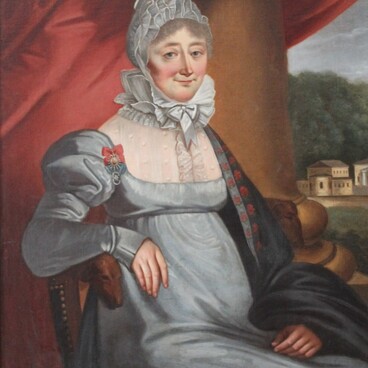In 1772, Empress Catherine the Great granted some land outside Moscow in the Khatunskaya District to Count Alexei Orlov. He shared some of that land with his brother Vladimir who resigned from service in 1774. That same year Count Vladimir Orlov commissioned the construction on the Lopa River of the Solace estate, and in 1783, he purchased the nearby village of Semenovskoye from his brother.
Vladimir Orlov had a vision that the structures of the estate had to be reminiscent of the manor of a British lord. The count invited the best architect of the time, whose name, unfortunately, has since been forgotten. Researchers hypothesize that the main house in the Solace estate may have been designed by Moscow-based civil engineer Carl Blank or by Russian architect Vasily Bazhenov. The floor plan is similar to the pavilions of the Mikhailovsky castle in Saint Petersburg that were designed by Vasily Bazhenov. In her book, The Estates of the Moscow Region, Vera Glushkova, a Ph.D. in geography, writes that the house was built in 1775–1779, the drawings for the structure had been developed by Blank while the construction work was supervised by serf architects Babakin and Tsukanov.
According to the plan, a three-story structure was supposed to be situated on a high hill next to a church; however, Orlov wanted a two-story house closer to the river bank. A landscape park was set up around the estate house that was eventually sited at the foot of the hill with nightingales, tame elk, roes, and deer being bred in there. The deer were later sold as taking care of them proved too expensive. The park had numerous garden sculptures, grottos, gazebos, and pavilions. A fountain was built next to the house in the midst of numerous flower beds.
In 1777, permission was given to build the church of Nicolas the Wonder Maker with the Vladimirsky side chapel. The utility structures included greenhouses, a brick barn decorated with white stones, and a pseudo-gothic blacksmith workshop.
The Solace is one of the largest estate complexes in the vicinity of Moscow to have preserved its original look from the 18th–19th centuries. The house was used as living quarters by the counts until 1917. The painting ‘The Solace dacha of counts Orlov outside Moscow’ was painted by Austrian landscape artist Johann Nepomuk Rauch in 1838.
Vladimir Orlov had a vision that the structures of the estate had to be reminiscent of the manor of a British lord. The count invited the best architect of the time, whose name, unfortunately, has since been forgotten. Researchers hypothesize that the main house in the Solace estate may have been designed by Moscow-based civil engineer Carl Blank or by Russian architect Vasily Bazhenov. The floor plan is similar to the pavilions of the Mikhailovsky castle in Saint Petersburg that were designed by Vasily Bazhenov. In her book, The Estates of the Moscow Region, Vera Glushkova, a Ph.D. in geography, writes that the house was built in 1775–1779, the drawings for the structure had been developed by Blank while the construction work was supervised by serf architects Babakin and Tsukanov.
According to the plan, a three-story structure was supposed to be situated on a high hill next to a church; however, Orlov wanted a two-story house closer to the river bank. A landscape park was set up around the estate house that was eventually sited at the foot of the hill with nightingales, tame elk, roes, and deer being bred in there. The deer were later sold as taking care of them proved too expensive. The park had numerous garden sculptures, grottos, gazebos, and pavilions. A fountain was built next to the house in the midst of numerous flower beds.
In 1777, permission was given to build the church of Nicolas the Wonder Maker with the Vladimirsky side chapel. The utility structures included greenhouses, a brick barn decorated with white stones, and a pseudo-gothic blacksmith workshop.
The Solace is one of the largest estate complexes in the vicinity of Moscow to have preserved its original look from the 18th–19th centuries. The house was used as living quarters by the counts until 1917. The painting ‘The Solace dacha of counts Orlov outside Moscow’ was painted by Austrian landscape artist Johann Nepomuk Rauch in 1838.

